
When we do anything in life, most of us measure our performance against a predefined set of metrics. Measuring your progress against these metrics is the only way to know whether you’re improving or not, and where you need to focus your attention. Key performance indicators (KPIs) are absolutely necessary for retailers looking to learn more about their own inventory management performance over time and monitor progress.
There are many aspects of a retail store that need to be measured and monitored over time. Let’s go over five inventory KPIs that measure how your merchandise is performing and how it is affecting your business.
1. Sales by category
This KPI answers the question: what categories are customers responding to the most or the least?
How does sales by category help me understand inventory performance?
Breaking down sales by category provides more detail on total sales and answers the following questions: Which categories are performing better than others? Did certain brands fail to live up to expectations?
According to retail expert Paul Erickson, Senior Vice-president of Client Services at RMSA Retail Solutions, you want to use the rule of ten when creating a hierarchy for your merchandise.
What is the rule of ten?
Your merchandise hierarchy should have no more than 10 departments, 10 classes or subclasses. Take the time to properly set up your merchandise hierarchy. Without the right merchandise categories in place, it will be difficult to identify actionable information.
2. Inventory turnover
Sometimes called “stock turn,” this KPI answers the question: is my inventory selling fast enough over the year?
Why is inventory turnover useful?
Why is it so important to measure inventory turnover for your retail store? Because as long as your stock is turning, you have cash flow. Stock that sits on your shelf for too long ties up your cash. It also increases cost and bores your customers. Stock that moves quickly off your shelf lets you bring in more, freeing up cash and enticing customers to keep coming back.
How to calculate inventory turnover or stock turn
First, determine Average Monthly Inventory, by adding up all the beginning inventories for the year (at retail price), plus your ending inventory (at retail price), and divide it by 13. Use an average inventory so that you don’t make calculations based on a month when inventories are particularly high or low.
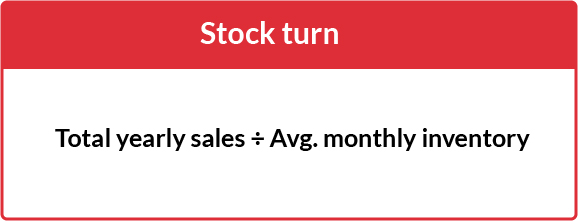
To calculate your average monthly inventory, use this calculation.
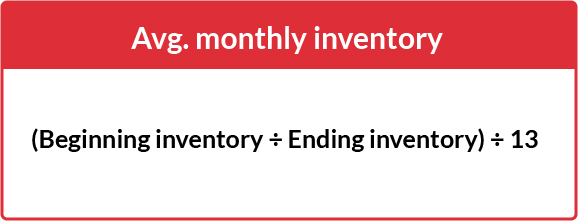
Stock Turn rates vary depending on the type of store you are operating which is why it’s so important to track this inventory turnover KPI even if you’re an experienced store owner. For instance, large discount retailers turnover inventory at a rate of 7 to 8.75 times a year whereas luxury retailers might turn inventory only 1.5 times a year.
Seasonal retailers, such as apparel and shoes, should aim for a turn rate of once per season ( four times a year).
3. Gross margin return on investment (GMROI)
This KPI answers the question: how effective is my inventory at generating cash flow and profits?
Why is GMROI useful?
GMROI is a bit intimidating, but it is one of the most important metrics you can use in your store. It tells you how hard your inventory is working for you, helping earn you profits. GMROI is a key metric for protecting your cash flow. Many retailers protect their margins, which is important, but remember that you can live for a while without profits. You can’t live without cash flow.
Some of your inventory will turn slowly but produce high margins. Some will produce low margins but turn quickly. Both of these situations will produce a good to high GMROI, says Erickson.
A low GMROI tells you if a product is either moving too slowly, has insufficient margin, or both. Fortunately, you can use the GMROI formula to effectively gauge product performance.
How to calculate GMROI
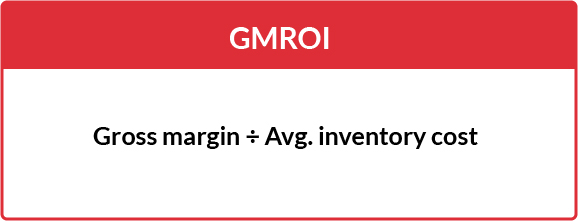
Keep in mind
- GMROI is best used for assessing inventory performance for products or product categories.
- GMROI is typically measured on an annual basis, and you should aim to increase it every year.
- Aim for a GMROI benchmark of at least 2 or 200%.
4. Sell-through rate
This KPI answers the question: how much stock has sold?
Why is sell-through useful?
Sell-through tells you how fast your inventory is moving. 100% sell-through means that you have completely sold out, while 0% means that you have not sold any. Similar to inventory turnover, sell-through can be useful throughout the year. Use inventory turnover when planning for the year and season, and sell-through to keep core products stocked up throughout the year.
How to calculate sell-through rate
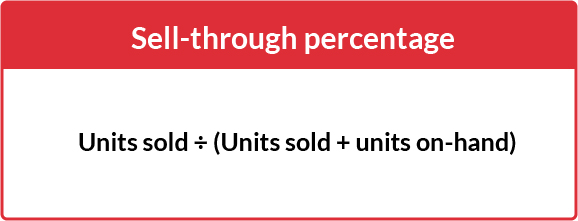
Keep in mind
- Seasonal retailers should look at sell-through at least every four weeks. Faster turning retailers, like dollar stores, look at sell-through daily.
- According to retail expert Karim Kanji, most retailers are looking at an 80 percent sell-through rate by the time their markdown period begins.
5. Weeks of Supply (WOS)
This KPI answers the question: how much do I need to buy or markdown?
Why is weeks of supply useful?
Weeks of Supply measures inventory levels in terms of time. It tells you how long you’ll have inventory on-hand if the item continues to sell at the current rate, and it is important for monitoring inventory performance keeping your shelves stocked. One Harvard study found that retailers lost nearly half of intended purchases because the item the customer wanted wasn’t in the store.
How to calculate weeks of supply
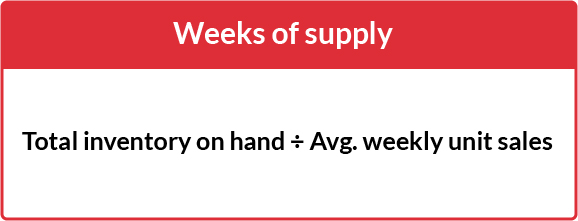
Keep in mind:
- For most seasonal retailers, the “sweet spot” for Weeks of Supply is 10-12 weeks.
- Setting automated reminders when Weeks of Supply fall below a set level is extremely helpful for making sure you don’t run out of stock. Set triggers in your POS to remind you when you fall below a certain threshold.
Measuring your inventory performance
In order to measure how your merchandise is performing, you need to calculate the Weeks of Supply, sell-through, gross margin return on investment, sales by category and Stock Turn. By identifying and tracking these KPIs, you’re adding a new level of insight into your management, setting yourself up to succeed and see better numbers, year after year.

News you care about. Tips you can use.
Everything your business needs to grow, delivered straight to your inbox.




